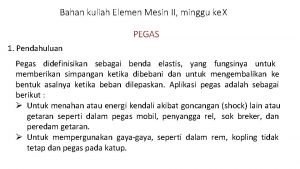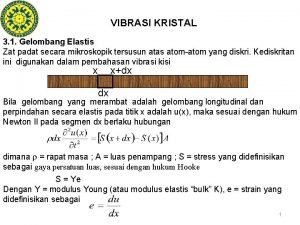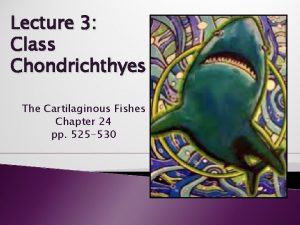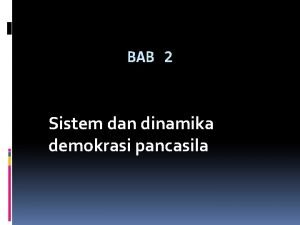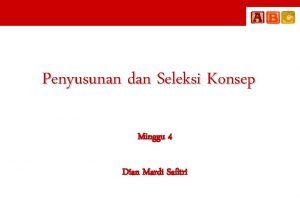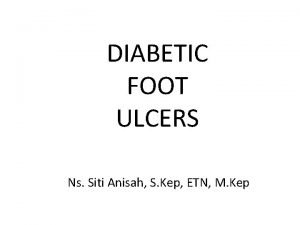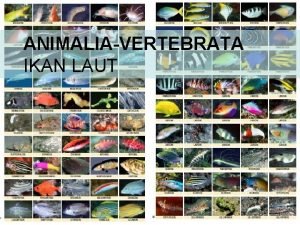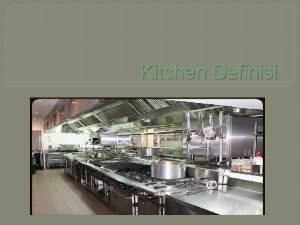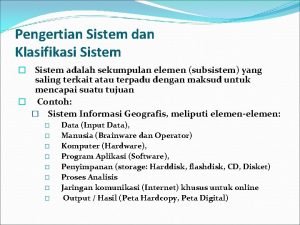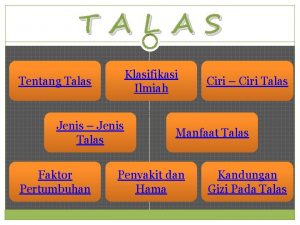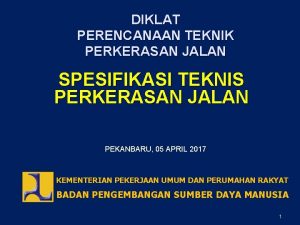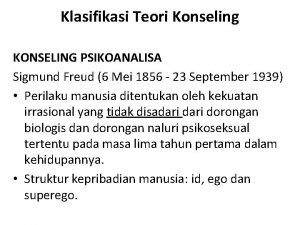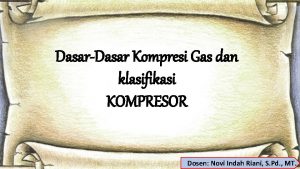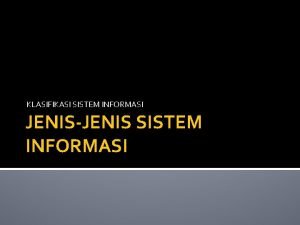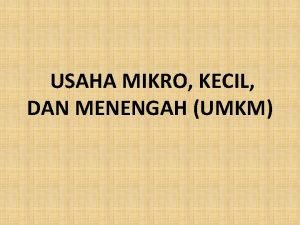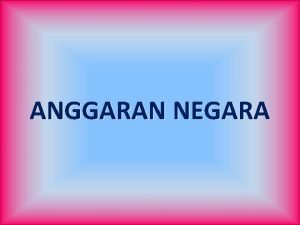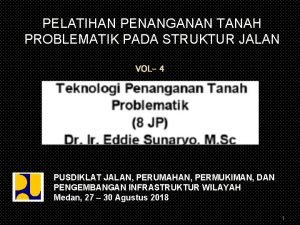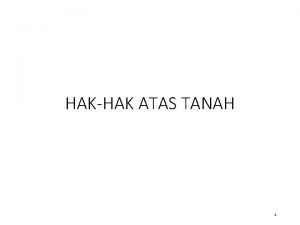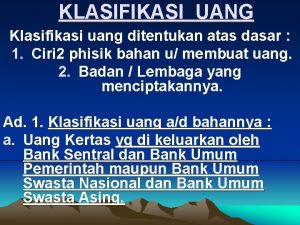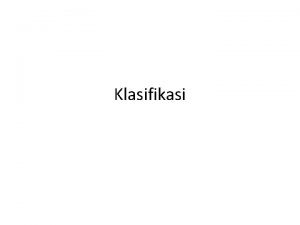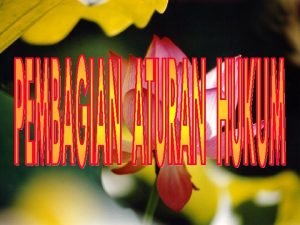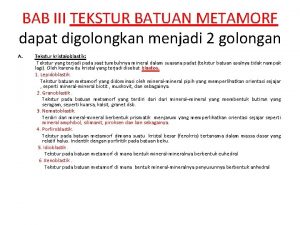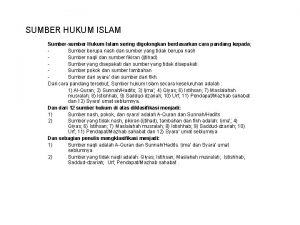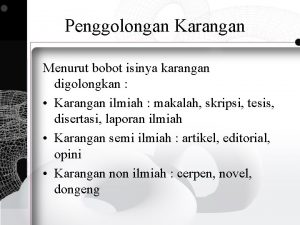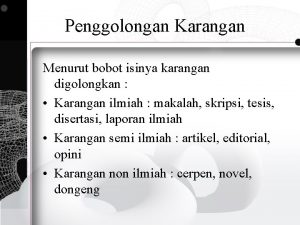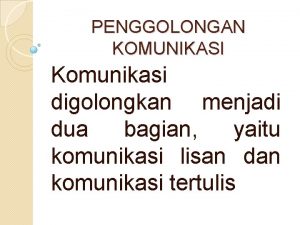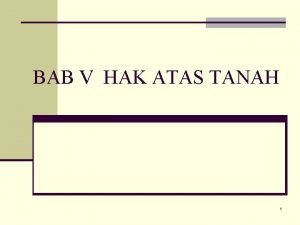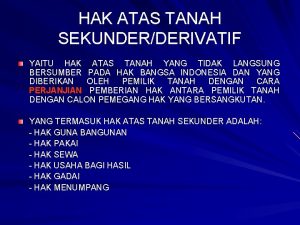SPRING PEGAS KLASIFIKASI PEGAS Pegas dapat digolongkan atas









































- Slides: 41

SPRING (PEGAS)

KLASIFIKASI PEGAS Pegas dapat digolongkan atas dasar jenis beban yang dapat diterimanya yaitu : • Pegas Tekan • Pegas Tarik • Pegas Puntir Sedangkan jika dipandang dari segi bentuk, maka pegas dapat dibedakan menjadi lima bagian, yaitu : o Pegas Volut o Pegas Daun o Pegas Piring o Pegas Cincin o Pegas Batang Puntir o Pegas Spiral atau Pegas jam

Types of springs 1. Helical springs 2. Conical and volute springs 3. Torsion springs 4. Laminated or leaf springs 5. Disc or bellevile springs

1. Helical Spring A helical spring is made up of a wire coiled in the form a helix -Compression helical springs -Tension helical spring Helical Springs -Circular -Square -Rectangular Closely Coiled HS Open Coiled HS

1. Helical Spring Compression Spring (Pegas Tekan) 1. Fungsi : a. Menyimpan gaya yang selanjutnya dikonversikan menjadi energi b. Peredam 2. Penggunaan : a. Persenjataan b. Sistem suspensi c. Pembatasan Gaya (pada pengepresan)

1. Helical Spring Pegas Tarik (Tensile Spring) 1. Fungsi : a. Penyiman gaya b. Penyimbang 2. Penggunaan : a. Timbangan b. Standrt c. Tromol

2. Pegas Kerucut (Volute Spring & Conical spring) 1. Fungsi : a. Memberi reaksi dan mengatur tekanan 2. Penggunaan : a. Penutup cup mobile b. Pembersi kaca di mobil

2. Pegas Kerucut (Volute Spring & Conical spring) Volute Spring Conical Spring

2. Pegas Kerucut (Volute Spring & Conical spring) The characteristic of volute / conical spring is sometimes utilised in vibration problems where springs are used to support a body that has a varying mass.

3. Torsion Springs 1. Helical Torsion Spring 2. Spiral torsion spring 1. Fungsi : a. Menerima beban dan memberi reaksi puntiran b. Penyeimbang c. Suspensi 2. Penggunaan : a. Handle mobil b. Penjepit

3. Torsion Springs Helical Torsion Spring Spiral Torsion Spring

The Analysis of Compression Springs 1. 2. 3. 4. 5. Solid Length When the coils contact with each other Free Length The normal condition of compression springs Spring Index Ratio of mean diameter of the coil & the diameter of the wire Spring Rate The load required per unit deflection of the spring Pitch the axial distance between adjacent coils in uncompressed state. (P) Equilibrium under the action of two forces (W) and the Twisting moment (T)

The Analysis of Compression Springs D = Mean diameter of the spring coil d = Diameter of the spring wire n = Number of active coils G = Modulus of rigidity for the spring material W = Axial load on the spring fs = Shear stress induced in the wire due to the twisting moment C = Spring index = D/d p = Pitch of the coils δ = Deflection of the spring, as a result of an axial load. Ot only shear stress induced in the wire, the following stresses also act on the wire : 1. Direct shear stress due to the load W 2. Stress due to curvature of wire.

The Analysis of Compression Springs The direct stress due to the load W = Load / Cross-sctional area of the wire -Direct Shear - Curvature of the wire The maximum shear stress The effect Substituting D/d=C A shear stress factor (K) / Wahl Stress factor Dimana K yaitu :

The Analysis of Compression Springs The values of K for a given index C Wahl’s stress factor oncreases very rapidly as the spring index decreases. In machinery the mostly used spring index above 3.

The Analysis of Compression Springs The standard size of the spring wire may be selected from the following table

The Type of End Connections for Helical Springs Plain ends Squared ends Ground ends Squared & Ground ends

The Characteristic of End Connections for Helical Springs 1. Inactive Coils The part of the coil which is in contact with the seat does not contribute to spring action. 2. Active Turns The part of the springs that action.

The Connections of Tensile for Helical Springs - Large stress concentration is produced at this point. - Attaching device of tension spring

The Connections of Tensile for Helical Springs A Compression Spring Tensile Spring

Deflection of helical springs of circular wire Axial deflection of spring Spring Rate / Stiffness of the Spring Constant

Energy stored in helical springs of circular wire Asumtion load is applied gradually V = Volume of the spring wire If : P = load h = height

Stress and deflection in helical springs of noncircular wire

Helical Torsion Springs -The ends are shaped to transmiit torque. - Bending stress - The radius of curvature of the coils changes when the twisting moment is applied Bending Stress Total Angle of Twist / Angular Deflection

Flat Spiral. Springs Long thin strip of elastic material wound like a spiral. - Watches - Gramaphone Since the radius of curvature of every spiral decreases when the spring is wound up, therefore the material of the spring is in a state of pure bending.

Flat Spiral. Springs Bending Moment B at max distance from the application of P Bending Moment Maximum bending stress Deflection (angular) Asumtion : both ends of the spring are clamped Deflection Strain energy stored in the spring

4. Pegas Daun / Leaf Spring (laminated or carriage spring) Application : For heavy vehicles, they have the advantage of spreading the load more widely over the vehicle's chassis, whereas coil springs transfer it to a single point. Thereby saving cost and weight in a simple live axle rear suspension.

4. Pegas Daun / Leaf Spring (laminated or carriage spring ) Flat spring Deflection :

4. Pegas Daun / Leaf Spring (laminated or carriage spring ) Bending Stress Full length graduated Nipping Equalised Stress in full length = 50% Stress in graduated Should be equal The Steps : 1. Making full length smaller thickness than the graduated leaves. 2. Given greater radius of curvature to the full length than graduated.

4. Pegas Daun / Leaf Spring (laminated or carriage spring ) Nipping The Value of initial Gap (Nip C) The Load on the clip bolt Wb Final Stress = Stress in the full length due to applied load minus the initial stress 1. The final stress equal to graduated due to applied load plus initial stress. 2. The deflection due to applied load is same as without initial stress

4. Pegas Daun / Leaf Spring (laminated or carriage spring ) The lenght of the leaf spring leaves The effective Band is used U-Bolts is Used The length of leaves Smallest leaf Next leaf Length of (n-1)th leaf

4. Pegas Daun / Leaf Spring (laminated or carriage spring ) Length of master leaf d = diameter of eye t = thickness of master leaf Standart sizes of automobile suspension springs 1. Standart nominal widths : 32, 40*, 45, 50*, 55, 60*, 65, 70, 80, 90*, 100 & 125 mm. 2. Standart nominal thickness : 3, 2; 4, 5; 5; 6; 6, 5; 7; 7, 5; 8; 9; 10; 11; 12; 14; & 16 mm 3. The recommended eye bore diametrs : 19, 20, 22, 23, 25, 27, 28, 30, 32, 35, 38, 50, & 55 mm. 4. The diameter of centre bolts:

4. Pegas Daun / Leaf Spring (laminated or carriage spring ) 5. Clip section and sizes of rivets & bolts

4. Pegas Daun / Leaf Spring (laminated or carriage spring ) Materials for leaf springs 1. Automobiles : 50 Crl, 50 Crl V 23, 55 Si 2 Mn 90 (Hardened & Tempered) 2. Rail road C 55 (water – Hardened), C 75 (oil – Hardened), 40 Si 2 Mn 90 (Water – Hardened), 55 Si 2 Mn 90 (oil – Hardened) 3. All values are for oil quenched condition and for single heat only.

B. Bahan Pegas (Material) Depends on what they are used 1. Severe service 2. Average service 3. Light service Severe service Rapid continous loading Ratio of minimum to maximum load is one half Automotive valve springs Average service Intermittent operation loading Ratio of minimum to maximum load is one half Engine - Governor springs Light service Very infrequently varied Load Safety valve springs

B. Bahan Pegas (Material)

B. Bahan Pegas (Material)

B. Bahan Pegas (Material)

B. Bahan Pegas (Material) -The material treatment of helical springs both Cold Formed or Hot Formed. -The material treatment depends on the size of the wire. -Wires : < 10 mm Cold > 10 mm Hot - The Srength size - Small size have greath strength & less ductility cold working

Sumber http: //www. masterspring. com/spring-wire-form-products/custom-springs/torsion -springs/ http: //www. enginehistory. org/Propellers/Governors/hydgov. shtml http: //www. automotiveillustrations. com/tutorials/how-to-draw-a-car. html http: //www. islandnet. com/~westisle/History/steam 2. html http: //www. tanhov. com/Product. Show/Pressure-Safety-Valve/Balance-Bellows. Safety-Valve-With-Jacket. html springsandthings. com alibaba. com

A semi-elliptical laminated vehicle spring to carry a load. . kg is to consist of seven leaves. . . cm wide, two of the leaves extending the full length of the spring. The spring is to be 110 cm in length and attached to the axle by two U-bolts. . Cm apart. These bolt hold the central portion of the spring so rigidly that they may be considered equivalent to a band having a width equal to the distance between bolts. The leaves are to be silico-manganese steel. Assuming an allowable stress of 3500 kg/cm 2, determine : a. Thickness of the leaves b. Deflection of the spring c. Diameter of the eye d. Length of the leaves e. Radius to which leaves should be initially bent Assume modulus of elasticity as 2, 1 x 10^6 kg/cm 2
 Petunjuk arah pada peta
Petunjuk arah pada peta Spring summer month
Spring summer month Bae yong-kyun
Bae yong-kyun Untuk menarik sebuah koper beserta isinya
Untuk menarik sebuah koper beserta isinya Kawat piano dari baja panjangnya 1 6 m
Kawat piano dari baja panjangnya 1 6 m Gaya pemulih
Gaya pemulih Konstanta pegas
Konstanta pegas Pegas helik
Pegas helik Frekuensi sudut pegas
Frekuensi sudut pegas Gambar susunan pegas campuran
Gambar susunan pegas campuran Klasifikasi tanah uscs
Klasifikasi tanah uscs Klasifikasi chondrichthyes
Klasifikasi chondrichthyes Klasifikasi demokrasi berdasarkan titik berat perhatiannya
Klasifikasi demokrasi berdasarkan titik berat perhatiannya Pohon klasifikasi konsep
Pohon klasifikasi konsep Wagner-meggitt classification of diabetic foot
Wagner-meggitt classification of diabetic foot Dr qaira anum
Dr qaira anum Barang semi publik
Barang semi publik Epipelagis
Epipelagis Apa itu kitchen
Apa itu kitchen Klasifikasi sistem adalah
Klasifikasi sistem adalah Klasifikasi talas
Klasifikasi talas Ukuran ayakan pasir
Ukuran ayakan pasir Snellen chart
Snellen chart Klasifikasi psikologi konseling
Klasifikasi psikologi konseling Klasifikasi teknologi informasi
Klasifikasi teknologi informasi Klasifikasi abk
Klasifikasi abk Kompresi isotermal
Kompresi isotermal Klasifikasi syariah
Klasifikasi syariah Klasifikasi sistem informasi didasarkan pada
Klasifikasi sistem informasi didasarkan pada Spektrum garis
Spektrum garis Klasifikasi usaha mikro kecil dan menengah
Klasifikasi usaha mikro kecil dan menengah Status gizi menurut who
Status gizi menurut who Klasifikasi sistem manufaktur
Klasifikasi sistem manufaktur Klasifikasi kelompok sosial menurut emile durkheim
Klasifikasi kelompok sosial menurut emile durkheim Peranan basidiomycota
Peranan basidiomycota Klasifikasi dan karakteristik anggaran negara
Klasifikasi dan karakteristik anggaran negara Peta konsep sumber daya alam
Peta konsep sumber daya alam Klasifikasi negara modern
Klasifikasi negara modern Aplikasi standar intervensi keperawatan indonesia
Aplikasi standar intervensi keperawatan indonesia Tabel klasifikasi tanah aashto
Tabel klasifikasi tanah aashto Pengertian account receivable
Pengertian account receivable Klasifikasi gastropoda
Klasifikasi gastropoda







